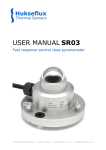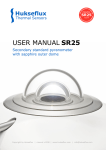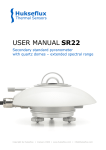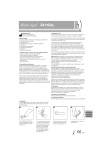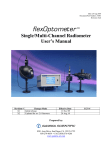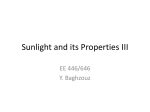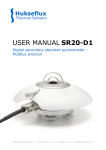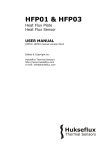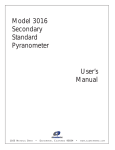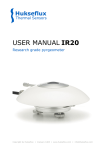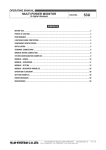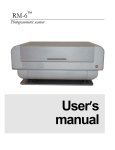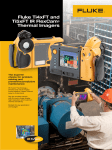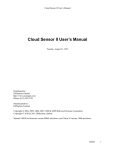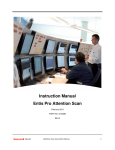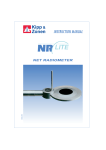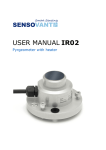Download DR01 DR02 manual - Hukseflux - Thermal Sensors
Transcript
DR01 First class pyrheliometer DR02 Fast response first class pyrheliometer USER MANUAL DR01 DR02 manual v1225 Warning Warnings and safety issues: DR01 and DR02 are passive sensors, and do not need any power. Window heating however does require 12 VDC for heating at 0.5 Watt. Putting more than 12 Volt across DR01 or DR02 sensor wiring can lead to permanent damage to the sensor. DR02 should not be used in combination with datalogging with open circuit detection. D R 01 D R 0 2 man u al v12 25 2/ 19 Contents Warning Contents List of symbols Introduction Checking at delivery 1. Presence of parts 1.1 Options 1.2 Functionality of the instrument 1.3 Instrument principle 2. Specifications of DR01 / DR02 3. Installation 4. Installation 4.1 Electrical connection 4.2 Dimensions 5. Maintenance and troubleshooting 6. Maintenance 6.1 Testing and troubleshooting 6.2 Requirements for data acquisition / amplification 7. Appendices 8. Appendix on cable extension / replacement 8.1 Appendix on calibration 8.2 Appendix on sensor coating 8.3 Declaration of conformity CE 8.4 D R 01 D R 0 2 man u al v12 25 2 3 4 5 6 6 6 6 7 8 10 10 10 12 13 13 13 15 16 16 16 17 18 3/ 19 List of symbols Voltage output Sensitivity of DR01 / DR02 Solar irradiance D R 01 D R 0 2 man u al v12 25 U E Φ μV μV/(W/m2) W/m2 4/ 19 Introduction DR01 and DR02 are research grade direct normal incidence (DNI) solar irradiance sensors, also known as pyrheliometers. They comply with ‘First Class’ classification, as per the latest ISO 9060 standard and ‘Good Quality’ from WMO. A unique product feature is the heated window. DR01 and DR02 are typically mounted on a solar tracker. DR02 is the fast-response equivalent of DR01. The only difference is in detector technology, resulting in a much faster response time (95 %) for DR02: 2 s instead of traditional 18 s. DR02 offers a wider measurement range (0 to 4000 W/m2) and the possibility to improve the temperature response as well. In this manual, DR01 is the pyrheliometer mentioned; DR02 wil be mentioned only in case this is necessary. DR01 window assembly features a precision ground and polished quartz window, for true spectral solar transmission ranging from 0.2 to 4.0 x 10-6 m. As per the latest ISO 9060 and WMO standards, the full opening view angle of the DR01 is collimated precisely to 5 degrees, for direct normal incidence solar irradiance measurement. Capable of measuring up to 2000 W/m2 (DR02: up to 4000 W/m2), the DR01 pyrheliometer can be deployed anywhere on earth. The instrument employs a passive thermopile-based sensing technology that generates a low level DC millivolt output signal proportional to the normal incident direct solar flux received at the detector surface. The DR01 also features a thermally isolated low power window heater in the window; when cycled on/off prior to sunrise the heater effectively eliminates the formation of dew on the pyrheliometer window. This results in improved post sunrise measurement accuracy, as well as lower maintenance, as it requires less cleaning. Determining direct solar irradiance with the DR01 requires connection to a data acquisition and a two-axis solar tracker platform. Typical pyrheliometer measurement applications include solar renewable resource assessment, concentrated PV electricity output validation, solar collector and PV panel efficiency validation, material testing research. Each DR01 is calibrated upon manufacture and delivered standard with a WRR (World Radiometric Reference) traceable certificate of calibration. Options include: extended cable lengths, AC100 / AC420 amplifiers, temperature sensors (Pt100 or 10 kOhm thermistor) and temperature dependence characterisation. Various tracking solutions can be offered by Hukseflux. Figure 0.1 DR01 first class pyrheliometer D R 01 D R 0 2 man u al v12 25 5/ 19 1. Checking at delivery 1.1 Presence of parts Arriving at the customer, the delivery should include: - pyrheliometer DR01 - cable of the length as ordered - calibration certificate matching the instrument serial number - any other options as ordered It is recommended to store the certificate in a safe place. 1.2 Options -longer cable, in multiples of 5 m -internal temperature sensor -temperature dependence characterisation 1.3 Functionality of the instrument Testing the instrument can be performed by using a simple handheld multimeter. See Chapter 6.2 on testing and troubleshooting on this subject. The programming of dataloggers is the responsibility of the user. Please contact the supplier to see if directions for use with your system are available. In case programming for similar instruments is available, this can typically also be used. D R 01 D R 0 2 man u al v12 25 6/ 19 2. Instrument principle 2 2 4 3 1 5 7 6 Figure 2.1 DR01 pyrheliometer; (1) humidity indicator, (2) sights, (3) aperture tube, (4) protection cap, (5) window with heater, (6) cable gland, (7) cable DR01’s scientific name is pyrheliometer. A pyrheliometer measures the solar radiation flux with a field of view of 5 degrees. The solar radiation spectrum extends roughly from 300 to 2800 x 10-9 m. It follows that a pyrheliometer should cover that spectrum with a spectral sensitivity that is as “flat” as possible. For a correct measurement the DR01 should be pointed at the sun. In order to attain the proper spectral characteristics, a pyrheliometer’s main components are: 1 a thermopile sensor with a black coating. This sensor absorbs all solar radiation, has a flat spectrum from visible light to infra-red and has a near-perfect cosine response. 2 a quartz window. This window limits the spectral response from 200 to 4000 x 10-9 m (cutting off the part above 4000 x 10-9 m). Another function of the window is that it shields the thermopile sensor from convection. The black coating on the thermopile sensor absorbs the solar radiation. This radiation is converted to heat, which flows through the sensor to the DR01 housing. The thermopile sensor generates a voltage output signal that is proportional to the solar radiation. D R 01 D R 0 2 man u al v12 25 7/ 19 3. Specifications of DR01 / DR02 DR01 serves to measure the solar radiation flux that is incident on a plane surface in W/m2 from a 5 degrees field of view (also called direct normal incidence radiation). Working completely passive, using a thermopile sensor, DR01 generates a small output voltage proportional to this flux. The front window contains a heater that can be put on at nighttime to prevent dew deposition. It can only be used in combination with a suitable measurement system and tracker. DR02 is a fast-response version of DR01. Table 3.1 Specifications of DR01 and DR02 DR01 and DR02 ISO Specifications 1 Measurand Direct solar radiation 2 ISO classification First class pyrheliometer 3 Response time (time for 95 % response) DR01: 18 s DR02: 2 s 4 Zero offset (response to 5 K/h change in ambient temperature) < ± 1 W/m2 5 Non-stability (percentage change in responsivity per year) <±1% 6 Non-Linearity ( percentage deviation from < ± 0.3 % responsivity at 500 W/m2 due to change in irradiance within 100-1000 W/m2) 7 Spectral selectivity (percentage deviation of the product of spectral absorptance and spectral transmittance from the corresponding mean within 0.35 µm and 1.5 µm) <±1% 8 Temperature response ( percentage deviation due to change in ambient temperature within an interval of 50 K) DR01: < ± 1 % 9 (-10 to +40 °C) DR02: < ± 1 % (-10 to +40 °C) DR02: < ± 0.4 % (-30 to +50 °C) with correction in data processing, if opted for internal temperature sensor and temperature dependence characterisation (see options) Tilt response (percentage deviation from < ± 0.5 % the responsivity at 0 ° tilt (horizontal) due to change in tilt from 0-90 ° at 1000 W/m2 irradiance) DR01 and DR02 additional measurement specifications 10 Full field of view angle 5 ° 11 Slope angle 1 ° 12 Sensitivity (nominal) 10 x 10-6 V/(W/m2) 13 Expected voltage output Application with natural solar radiation: -0.1 to +30 x 10-3 V D R 01 D R 0 2 man u al v12 25 8/ 19 14 Rated operating temperature range -40 to +80 °C 15 Sensor resistance DR01: between 400 and 500 Ohm DR02: between 150 and 250 Ohm 16 Power required Zero (passive sensor), see also heater 17 Measurement range DR01: to 2000 W/m2 DR02: to 4000 W/m2 18 Expected accuracy for daily sums ±2% 19 Spectral range (50 % transmission points) 200 to 4000 x 10-9 m (the spectral responsivity of field pyrheliometers is limited to the range approximately 0.3 µm to 3 µm, depending on the spectral transmittance of the window which protects the receiver surface) 20 Drying cartridge/ humidity indicator Bag of silica gel, 0.5 g, 35 x 20 mm Humidity indicator B2 21 Required readout: 1 differential voltage channel or 1 single ended voltage channel 22 Programming Φ=U/E 23 Heater Heating front window: 0.5 Watt @ 12 VDC, typically activated during nighttime only to prevent dew deposition 24 Standard cable length / diameter 5 m / 5 mm (see options) 25 Cable gland Accepts cable diameter from 3 to 6.5 mm 26 Cable replacement Cable can be replaced by the user 27 Weight including 5 m cable, size 1.4 kg box of 43 x 11 x 11 cm 28 Tracking Not included, preferably within 1 degree Calibration 29 Calibration uncertainty < 1.3 % (k = 2) 30 Calibration traceability To WRR, procedure according to ISO 9059 31 Recommended recalibration interval Every 2 years (sensitivity) Options 32 Cable extension Longer cables can be supplied on request. Specify multiple of 5 m 33 Amplifiers AC100 and AC420 34 Temperature dependence characterisation 35 Temperature sensor Pt100 or 10K thermistor can be added DR01-T1 includes a Pt100 DR01-T2 includes a 10K thermistor DR02-T1 includes a Pt100 DR02-T2 includes a 10K thermistor DR01 and DR02 also comply with WMO specifications D R 01 D R 0 2 man u al v12 25 9/ 19 4. Installation 4.1 Installation DR01 is to be installed on a tracker, with an accuracy of 1 degree form true solar position. The mounting should be done by clamping around the DR01 tube (1.5 inch or 38 mm). 4.2 Electrical connection In order to operate, DR01 should be connected to a measurement system, or datalogger. DR01 is a passive sensor that does not need any power. DR02 should not be used in combination with datalogging with open circuit detection. Cables generally act as a source of distortion, by picking up capacitive noise. It is a general recommendation to keep the distance between data logger or amplifier and sensor as short as possible. For cable extension, see the appendix on this subject. Table 4.2.1 The electrical connection of DR01. Heater polarity is not important. PCB connection Description Wire colour 8 Thermopile [+] White 7 Thermopile [-] Green 1 Temperature sensor [+] (if present) Red 2 Temperature sensor [+] (if present) Brown 3 Temperature sensor [-] (if present) Yellow 4 Temperature sensor [-] (if present) Blue 5 Heater 12VDC [+] Pink 6 Heater 12VDC [-] Grey Ground Ground Black D R 01 D R 0 2 man u al v12 25 10/19 Figure 4.2.1 Electrical diagram of DR01 thermopile detector. The heater is a simple resistor on a separate cable.Temperature sensor is only present if ordered. D R 01 D R 0 2 man u al v12 25 11/19 5. Dimensions 380 Ø 38 50 215 Figure 5.1 Dimensions of DR01 in mm. Tube diameter is 38 mm, approximately 1.5 inch. D R 01 D R 0 2 man u al v12 25 12/19 6. Maintenance and troubleshooting 6.1 Maintenance Once installed DR01 is essentially maintenance free. Periodically dessicant may be replaced. Usually errors in functionality will appear as unreasonably large or unreasonably small measured values. As a general rule, this means that a critical review of the measured data is the best form of maintenance. Recommendations for maintenance are: 1. Critical review of data 2. Cleaning of window by water or alcohol 3. Inspection of interior of window; no condensation 4. Dessicant inspection: change in case the humidity indicator has turned pink. Regeneration is possible by heating more than 3 hours at 120 °C. Spanner size required for removal of dessicant is 20. 5. Pointing inspection: daily inspection against sight of the instrument. 6. Inspection of cables for open connections 7. Recalibration: suggested every 2 years, typically by intercomparison with a higher standard in the field. 6.2 Testing and troubleshooting This paragraph contains information that can be used for testing of the instrument and to make a diagnosis whenever the sensor does not function. 1. Check the impedance of the sensor between the green (-) and white (+) wire. Use a multimeter at the 1000 ohms range. (500 ohms for DR02). Measure the impedance at the sensor wires, first with one polarity, than reverse polarity. Take the average value. The typical impedance of the wiring is 0.1 ohm/m. Typical impedance should be the typical sensor impedance of DR01 (400500 ohms) or DR02 (150-250 ohms) plus 1 ohm for the total resistance of two wires (back and forth) of each 5 meters. Infinite indicates a broken circuit; zero indicates a short circuit 2. Check if the sensor reacts to light: put the multimeter at its most sensitive range of DC voltage measurement, typically 100 microvolt range or lower and expose the sensor to a strong light source, for instance a 100 Watt light bulb at 10 centimeter distance. The signal should read several millivolts now 3. Darken the sensor either by putting something over it or switching off the light. The instrument voltage output should go down and within one minute approach zero mV 4. Check if the right calibration factor is entered into the algorithm. Please note that each sensor has its own individual calibration factor 5. Check if the voltage reading is divided by the calibration factor by review of the algorithm 6. Check the condition of the leads at the logger 7. Check the cabling condition looking for cable breaks D R 01 D R 0 2 man u al v12 25 13/19 8. Check the range of the data logger; heat flux can be negative (this could be out of range) or the amplitude could be out of range 9. Check the data acquisition by applying a mV source to it in the 1 mV range 10. Check the presence of strong sources of electromagnetic radiation (radar, radio etc.) 11. Check the condition of the shielding 12. Check the condition of the sensor cable D R 01 D R 0 2 man u al v12 25 14/19 7. Requirements for data acquisition / amplification Table 7.1 Requirements for data acquisition and amplification equipment. 1 Capability to measure microvolt Preferably: 5 microvolt accuracy signals Minimum requirement: 20 microvolt accuracy (both across the entire expected temperature range of the acquisition / amplification equipment) 2 Capability for the datalogger or the software To store data, and to perform division by the sensitivity to calculate the solar irradiance 3 Heating power Heating is not a necessity. When used: 0.5 W at 12 VDC 4 Warning DR02 should not be used in combination with datalogging with open circuit detection. D R 01 D R 0 2 man u al v12 25 15/19 8. Appendices 8.1 Appendix on cable extension / replacement DR01 is equipped with one cable for the detector and heater. It is a general recommendation to keep the distance between datalogger or amplifier and sensor as short as possible. Cables generally act as a source of distortion, by picking up capacitive noise. DR01 signal cable can however be extended without any problem to 100 meters. If done properly, the sensor signal, although small, will not significantly degrade because the sensor impedance is very low. Cable and connection specifications are summarised below. NOTE: the body of DR01 contains connector blocks that can be used for internal connection of a new cable. Usually it is easier to connect a new longer cable than to extend an existing cable. Table 8.1.1 Specifications for cable extension 1 Cable 8-wire shielded, copper core 2 Core resistance 0.1 Ω/m or lower 3 Outer diameter (preferred) 5 mm 4 Outer sheet (preferred) polyurethane (for good stability in outdoor applications). 5 Connection Either solder the new cable core and shield to the original sensor cable, and make a waterproof connection using cable shrink, or use gold plated waterproof connectors. 8.2 Appendix on calibration The World Radiometric Reference (WRR) is the measurement standard representing the SI unit of irradiance. It was introduced in order to ensure world-wide homogeneity of solar radiation measurements and is in use since 1980. The WRR was determined from the weighted mean of the measurements of a group of 15 absolute cavity radiometers which were fully characterized. It has an estimated accuracy of 0.3 %. The WMO introduced its mandatory use in its status in 1979. The world-wide homogeneity of the meteorological radiation measurements is guaranteed by the World Radiation Centre in Davos Switzerland, by maintaining the World Standard Group (WSG) which materializes the World Radiometric Reference. http://www.pmodwrc.ch/ The Hukseflux standard is traceable to an outdoor WRR calibration. A small correction is made to transfer this calibration to the Hukseflux standard condition of 20 °C. D R 01 D R 0 2 man u al v12 25 16/19 Recalibration of field pyrheliometers is typically done by comparison in the field to a reference pyrheliometer. Hukseflux uses an indoor calibration. The main Hukseflux recommendation for re-calibration is, if possible, to perform calibration relative to a higher reference under clear sky conditions. 8.3 Appendix on sensor coating Figure 8.3.1 Top of the Hukseflux sensor coating on a glass substrate under a confocal laser microscope. The carbon based coating is highly porous, and every element acts as a light trap. The end result is a coating of very high absorption. The ends of carbon particles are in-focus, the outlines of the underlying layers can be seen out-of focus D R 01 D R 0 2 man u al v12 25 17/19 8.4 Declaration of conformity CE We of Hukseflux Thermal Sensors Delftechpark 31 2628 XJ Delft The Netherlands in accordance with the following Directive: 2004/108/EC The Electromagnetic Compatibility Directive hereby declare that: Equipment: Type: pyranometer/ radiometer/ heat flux sensor DR01 and DR02 are in conformity with the applicable requirements of the following documents Emission: Immunity: Emission: Emission: EN EN EN EN 61326-1 (2006) 61326-1 (2006) 61000-3-2 (2006) 61000-3-3 (1995) + A1 (2001) + A2 (2005) I hereby declare that the equipment named above has been designed to comply with the relevant sections of the above referenced specifications and is in accordance with the requirements of the Directive. Delft September 2011 D R 01 D R 0 2 man u al v12 25 18/19 © Hukseflux Thermal Sensors B.V., 2013 www.hukseflux.com Hukseflux Thermal Sensors B.V. reserves the right to change and/or alter specifications without notice.




















